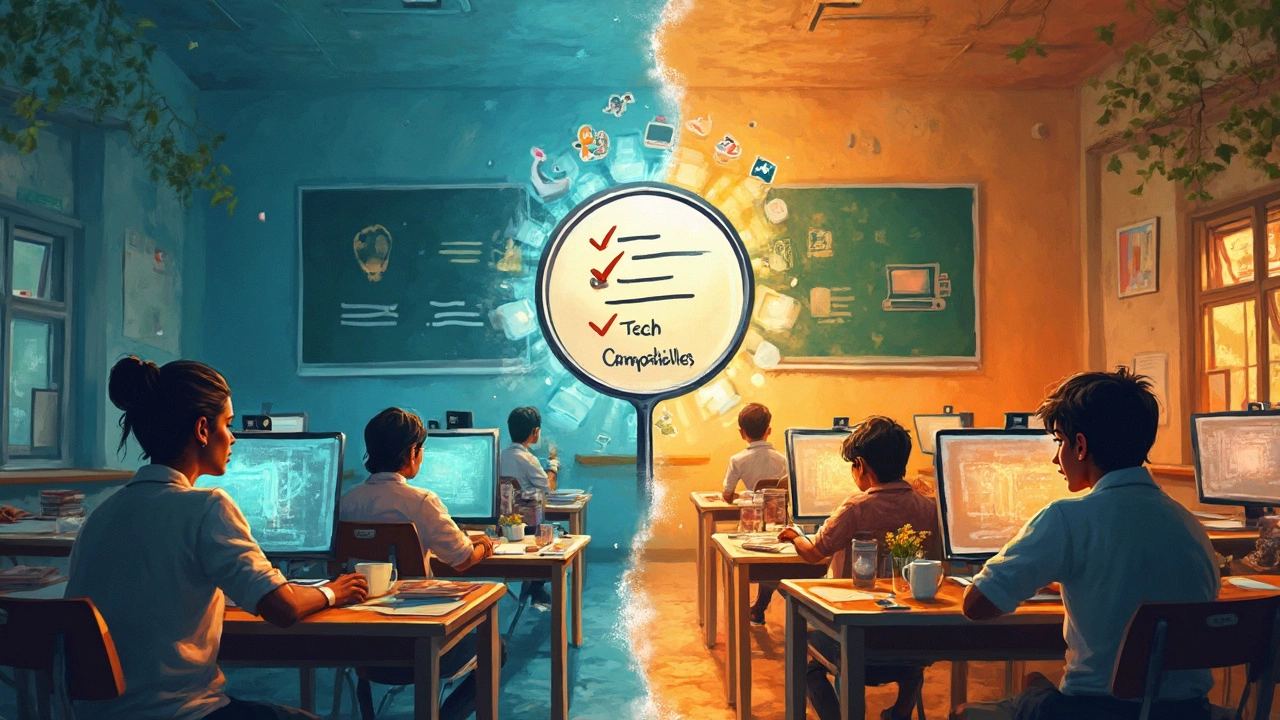At first glance, Google Classroom has a lot going for it. It's free, runs in a browser, and pretty much every student has seen a Google login page. But if you look around, not every school actually uses it. Kind of weird, right?
Here’s the thing: picking a platform for an entire school or district isn’t just about what works in one classroom. Schools have to think about student privacy, tech policies, teacher comfort, and sometimes, what parents want. It's not as simple as signing up with an email address. There’s a lot that goes on in the background—legal stuff, tech requirements, training, and even local politics.
Before you assume Google Classroom is the default, it helps to know why some schools pass on it. Understanding these reasons can save you a ton of time and frustration if you’re a teacher, parent, or even a student trying to make sense of all the digital learning tools out there.
- The Appeal of Google Classroom
- Barriers to Adoption in Schools
- Privacy and Data Security Concerns
- Teacher Training and Preferences
- What Schools Use Instead
The Appeal of Google Classroom
At the surface, Google Classroom seems like a no-brainer for schools trying to get digital. It’s free for anyone with a Google account, and all you need is a device that can run a web browser. No fancy hardware or expensive software licensing drama. That alone cuts down the barriers to getting started with online assignments, tests, and feedback.
Teachers love the simplicity. Drag and drop assignments, automatic grading for basic quizzes, and built-in collaboration with Google Drive, Docs, and Slides—most teachers have used these before, so hardly any learning curve. Students turn in their assignments with a click. Parents can even get email summaries about what their kids are missing. The whole workflow feels pretty streamlined, especially for people who already use Google's tools in their daily life.
- google classroom works directly in your browser—no install needed.
- Supports real-time comments and grading so students don’t have to wait.
- Seamless integration with Google’s cloud, so there’s barely any lost homework or tech glitches over “missing files.”
- Teachers can reuse assignments every year for different groups.
- It plays nicely with Chromebooks, and Chromebooks are already everywhere in U.S. schools—roughly 50% of school devices in 2024, according to Futuresource Consulting.
| Stat | Detail |
|---|---|
| Users Worldwide | Over 150 million |
| Cost to Schools | Free (with Google Workspace for Education) |
| Languages Supported | Over 50 |
| Devices Required | Any with web access (Chromebooks preferred) |
Google Classroom also nails access equity. Most districts are short on money, so being able to run the whole thing on a regular Chromebook means schools aren’t hunting for extra funding just to get started. Plus, it supports accessibility tools built into Chrome and even some cool AI features now—like smart suggestions when sending class announcements.
So, with all these perks, it’s kind of wild that every school isn’t on board. Clearly, there must be some big sticking points holding them back, which we’ll get into next.
Barriers to Adoption in Schools
It might sound simple to just roll out google classroom everywhere, but real world schools hit a ton of roadblocks. Some of these issues are technical, some come down to policy, and a few just plain involve people not wanting to change. Here’s what usually gets in the way.
- Device Compatibility: Not every school can hand out Chromebooks or laptops to every kid. Google Classroom works best in the Chrome browser or with Google accounts, and that’s an extra step when you have a mix of PCs, tablets, and outdated computers in the building. IT teams often find themselves wrestling with legacy systems or software that just won’t play nice.
- Internet Access: Don’t assume everyone has solid Wi-Fi at school—or at home. According to a 2023 report from the Pew Research Center, about 15% of U.S. households with K-12 students didn’t have reliable internet access, which is a major dealbreaker for any cloud-based tool.
- Data Ownership and Privacy: In the U.S., schools have strict rules under laws like FERPA and COPPA. Some districts just aren’t comfortable handing student data to a giant tech company, even with Google’s safeguards. Europe’s even tougher—Germany and France have banned Google Classroom in many districts because of privacy concerns.
- Admin Control: Some school IT admins want more customization and reporting tools than Google offers out of the box. They need centralized control, audit logs, and special integrations with their grading and attendance systems—which Google Classroom sometimes can’t deliver.
- Rolling Out Training: A new platform means training staff, answering questions, and creating lesson plans from scratch. If teachers don’t feel confident, they’ll push back hard or just find shortcuts.
- Cost of Add-Ons: Sure, the main Google Classroom platform is free, but add-ons for testing, attendance, or extra analytics often cost extra. That adds up, especially in big districts or those that already pay for other platforms.
| Barrier | How Common? | Impact |
|---|---|---|
| Old or mixed tech | Most public schools | Frequent log-in issues |
| Poor home internet | 15%+ families (US, 2023) | Students can’t participate as much |
| Privacy regulations | Very strict in EU, patchy in US | Restricted use or bans |
| Lack of teacher support | Reported in 60%+ rollouts | Slow adoption, wasted investments |
| Hidden costs | Common in districts | Budget overruns |
Once you stack all these up, it makes sense why districts often look for something else or just stick with what they know. Changing tools in schools is way more complicated than just clicking the “Sign up” button.

Privacy and Data Security Concerns
This is where things get a bit sticky. Schools have to jump through a lot of hoops to protect student info, and not every platform clears the bar. When you talk about google classroom, privacy worries come up fast. In the US, schools need to follow laws like FERPA (Family Educational Rights and Privacy Act) and COPPA (Children’s Online Privacy Protection Act). If these rules are broken, the school—not just the tech company—can get in trouble.
Here’s the kind of stuff schools ask about:
- What data does Google gather on students, and for what purposes?
- Where is student data stored, and who actually owns it?
- Can parents find out what info is collected or ask for it to be deleted?
- What happens if there’s a data breach?
Google says it doesn't use student data for advertising, and a lot of districts have agreements in place to limit data use. Still, plenty of schools worry about what happens when all those accounts are linked to one ecosystem. European schools, especially under GDPR, have sometimes backed away from Google Classroom because of stricter data handling laws.
For a quick view of what’s at stake, check out this table:
| Issue | Concern | Impact |
|---|---|---|
| Legal Compliance | FERPA, COPPA, and GDPR requirements | Risk of fines; forced platform changes |
| Data Storage | Servers often outside the country | Potential red flag for local districts |
| Parental Access | Hard for some parents to view or request deletion | Lack of transparency; trust issues |
| Data for Ads | Concerns over ad tracking and targeting | Student privacy at risk if policies change |
If you’re a teacher or IT admin, make sure to check if your school or district has signed a G Suite for Education agreement. It covers some privacy bases but doesn’t eliminate every risk. When in doubt, double-check your local laws and ask parents to review privacy policies, too. Being proactive goes a long way in keeping everyone’s data safe and sound.
Teacher Training and Preferences
One of the big reasons some schools skip Google Classroom is that not every teacher feels comfortable with it—or wants to use it. Switching to new tech means training, and that takes time most teachers don’t have. In surveys done during 2023 by EdTech magazine, more than half of teachers said they didn’t get enough help learning digital classroom tools. Training usually happens only once or for a few hours, and that’s just not enough for everyone to get up to speed.
Some teachers already have their favorite platforms. Maybe they’ve spent years building lessons in other systems, like Moodle or Microsoft Teams. If you tell them to drop all that and start fresh with Google Classroom, there’s bound to be pushback. Old habits stick, especially if the new tool doesn’t offer major upgrades or makes life more complicated.
Another thing most people don’t see: district tech teams often have to support a stack of different learning platforms. If only some teachers want Google Classroom, while others use something else, it turns into a patchwork mess. IT support and training get stretched thin, and teachers end up frustrated when they can’t quickly get answers or fixes.
Here are a few things schools can do to help teachers feel more confident when using any e-learning platform:
- Offer ongoing, hands-on workshops instead of just one-time meetings.
- Give teachers job-embedded support—so they can get tech help right in the classroom, not just in an after-school webinar.
- Make room for teacher feedback. If something about Google Classroom isn’t working, listen and adjust the plan.
One last tip: letting teachers try out the google classroom platform with a small test group before rolling it out schoolwide usually goes better than just turning it on for everyone. Slow and steady really helps tech stick around.

What Schools Use Instead
If a school isn’t using Google Classroom, they’re not just sticking with email and hope. There’s a whole world of digital classroom tools out there, some of which you might not even realize are big players. The most popular alternatives usually come down to what works best with a school’s setup and what ticks the boxes for district leaders, teachers, and IT departments.
The heavy hitter in a lot of districts is Schoology. Schoology is used heavily in public schools because it plays nicely with tons of other software, handles grading, and makes it easy to post resources. According to a recent survey from EdWeek, over 20% of school leaders said they rely on Schoology as their main classroom platform. It’s not free, but bigger districts often sign big contracts to keep everything running smoothly.
Another big name is Canvas. This one’s popular in high schools and even some colleges. Canvas is loved for its customization—schools can tweak it to do pretty much anything. Teachers like how easy it is to integrate with other software, like Zoom or Turnitin. There’s also Microsoft Teams for Education, which fits perfectly in schools already using Office 365. It doubles as a place for video calls, files, and class assignments, all in one.
- Schoology: Great for big districts, good reporting and grading tools, solid parent communication.
- Canvas: Ridiculously customizable, lots of third-party add-ons, good for advanced classes.
- Microsoft Teams: Easy for schools that already use Microsoft products, built-in chat and meetings, strong on security.
- Moodle: Open-source, which means schools with a tech crew can run it for free, but it’s less slick out of the box.
- Seesaw: More common in elementary schools; it’s simple, visual, and lets even young kids share work with parents.
One tech coordinator from Florida put it like this:
“We wanted a platform that worked with our grading and attendance system and gave teachers more control. Schoology just clicked for us.”
If you’re trying to figure out what’s right for your school, check the list above and see what other schools in your state are doing. Sometimes, local rules about student data or tech contracts steer districts toward one system over another. And remember, what works for one school might make no sense for another. The best platform is usually the one teachers and students can actually use without feeling lost.


